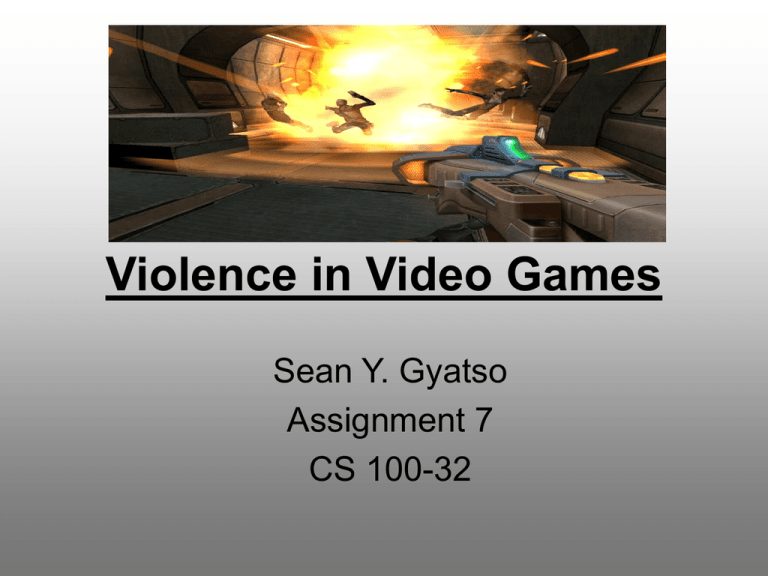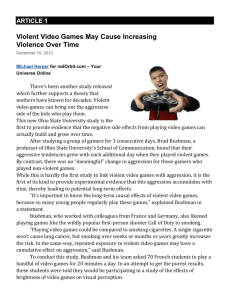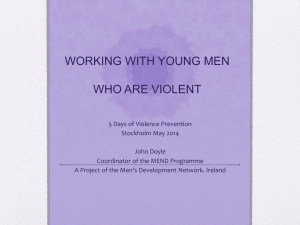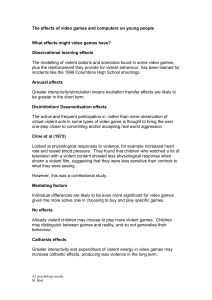Violence in Video Games
advertisement

Violence in Video Games Sean Y. Gyatso Assignment 7 CS 100-32 Technology has come a long way over the years. In the present time we are seeing more and more violence as technology advances. The main targets are young kids from ages 8 to 24 who are involved in playing video games. Some of the graphics on video games are affecting the kids in a psychological way. Where aggression, violent behavior and health are at risks. The video game industry is a multi-billion dollar industry that are making parents concerned about the kids spending to much time playing games. Therefore, we’ve raised the following questions: If you play video games with high violent content, does that mean that the gamer will show a greater degree of aggressiveness and violent towards others in everyday lives? If not, why not? Does the outcome depend on the personal and social characteristics of the gamer such as age, gender, and educational level? What are the advantages and disadvantages? The application of science, especially to industrial or commercial objectives. For example, on the market there is the Sony Playstation, Sony Playstation II, the X-Box, Nintendo 64, etc. However, the majority of games still consist of punching, kicking, whipping, shooting, or otherwise killing the opponent in order to win the game. “According, to Ken Writ, assistant vice-president of NEC, violent games are the most popular because the people who spend the most money on games are boys ages 10-16. People enjoy the action in violent games. In fact, between 1952 and 1964, television saw a 90% increase in violent programming. Advertisers and producers created more violent shows because it quickly became apparent that Americans would soon watch something violent than something non-violent. Video game is like a virtual world where you have to complete the mission of the game and get points for reward. From the beginning, video games have contained violence whether it is destruction or killing the bad guys. Early games like space invaders contain violence because the player destroys waves of alien aircrafts towards you. Some people might argue that this is not a violent game because it has cartoon like graphics and not to detailed, but the question is what happens when the story line involves human characters and the graphics are much more detailed, with advancement of new technology and programming techniques. In a nut shell On the other hand, good-quality video games offer lots of benefits to kids such as • provide a fun and social form of entertainment • encourage teamwork, and increase children's self-confidence and selfesteem as they master games • make kids feel comfortable with technology—particularly important for girls, who don't use technology as much as boys • develop skills in reading, math, and problem-solving • improve eye-hand coordination and fine motor skills The main concern that crosses many people’s mind is how violent games have become. Parents blame the companies for creating the aggression with held in the games. In 1990 the Nintendo Entertainment System sold over 7.2 million control decks, 60 million game packs 3.2 million Game Boy portable hand-held units 9 million Game Boy game packs. Conclusion In conclusion, although there are many studies examining the effects of video games and violence, these studies seem to focus mainly on the possible short-term aggressive effects. There are very few and incomplete studies of long-term effects from violent video games. Further studies on the long-term effects from violent video games are needed as experts mentioned. I felt that the games are not the problem, but the lack of parents being there for their kids. Also, it’s up to the individual to control themselves, which involves emotions and making the right decisions. Credit • Buchman, D., & Funck, J. (1996). Playing Violent and Computer Games and Adolescent Self-Concept. Communication, Vol.26 (2),19-32. • Violence and Video Games (n.d). Retrieved April 9, 2003, from http://www.gamezero.com • Quittner, J., (1999). Are Video Games Really so Bad?. Time, Vol.153 (18), 30-34. • Griffiths, M. (1999). Violent Video Games and Aggression: A Review of Literature. Aggression and Violent Behavior, Vol.4 (10), 203212.











